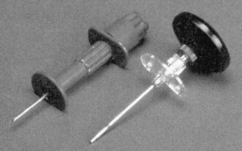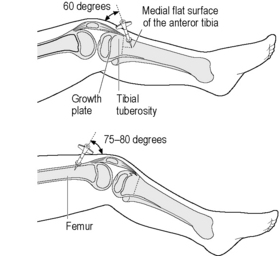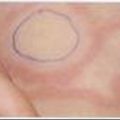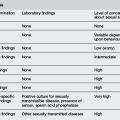23.11 Intraosseous infusions
Equipment
 A variety of needles will work. Butterfly needles and spinal needles may be effective, especially in neonates and infants, but these needles bend too easily in the more calcified bones of children and adolescents.
A variety of needles will work. Butterfly needles and spinal needles may be effective, especially in neonates and infants, but these needles bend too easily in the more calcified bones of children and adolescents. Commercially available IO needles have more durable parts intended for penetration of bone. There are several styles (Fig. 23.11.1). A central stylet is universal. There are short, 2.5-cm, needles for neonates and infants and longer, 3.0 and 3.5-cm, needles for older children. Some needles have stylets with multifaceted cutting edges intended for a rotary insertion, others have bevels, and others can be screwed in place. The shaft may have side ports.
Commercially available IO needles have more durable parts intended for penetration of bone. There are several styles (Fig. 23.11.1). A central stylet is universal. There are short, 2.5-cm, needles for neonates and infants and longer, 3.0 and 3.5-cm, needles for older children. Some needles have stylets with multifaceted cutting edges intended for a rotary insertion, others have bevels, and others can be screwed in place. The shaft may have side ports.Preparation
Identification of the entry site
The best site in children is the anteromedial aspect of the proximal tibia lateral to the tibial tuberosity. Alternative sites are the distal end of the femur 2–3 cm above the patella in the midline, and the medial malleolus at the ankle (Fig. 23.11.2). The sternum is not recommended in children. In adults, the medial malleolus may be the best site, although studies are lacking.
Procedure
 Introduce the IO needle in the skin, directed slightly away from the growth plate. Grasping the limb with the non-dominant hand beside the insertion site (e.g. behind the knee for proximal tibia insertion) helps to steady the bone during placement.
Introduce the IO needle in the skin, directed slightly away from the growth plate. Grasping the limb with the non-dominant hand beside the insertion site (e.g. behind the knee for proximal tibia insertion) helps to steady the bone during placement. Pierce the bony cortex with a firm, twisting motion from a position directly above the entry site. A ‘pop’ may be felt as the needle passes through the bony cortex and into the marrow cavity. Do not push too hard on the needle. Too much force may push the needle all the way through the bone and into the soft tissues.
Pierce the bony cortex with a firm, twisting motion from a position directly above the entry site. A ‘pop’ may be felt as the needle passes through the bony cortex and into the marrow cavity. Do not push too hard on the needle. Too much force may push the needle all the way through the bone and into the soft tissues. Remove the stylet and aspirate marrow contents with a 10-mL syringe. Keep any bone marrow aspirate for glucose check or for other tests in the emergency department. Sometimes, marrow cannot be aspirated.
Remove the stylet and aspirate marrow contents with a 10-mL syringe. Keep any bone marrow aspirate for glucose check or for other tests in the emergency department. Sometimes, marrow cannot be aspirated. Confirm correct placement by infusing 10 mL of normal saline without resistance. Once the IO needle has been placed, attach a stopcock (if available) to the end of the needle before attaching the intravenous (IV) line.
Confirm correct placement by infusing 10 mL of normal saline without resistance. Once the IO needle has been placed, attach a stopcock (if available) to the end of the needle before attaching the intravenous (IV) line.Tips
The EZ-IO
Mechanical devices such as the EZ-IO have simplified the insertion of an IO needle as they are not dependent on the manual process. The EZ-IO (Vidacare, San Antonio, TX, USA) is a reusable battery-powered device that operates like a small drill. The driver itself is a sealed unit that is good for about 700 insertions. The EZ-IO uses a bevelled drill tip that rotates into the IO space at a preset depth (Fig. 23.11.3).
Brunette D.D., Fischer R. Intravascular access in paediatric cardiac arrest. Ann Emerg Med. 1988;6:577.
Fiser D.H. Intraosseous infusion. N Engl J Med. 1990;322:1579.
Johnson L., Kissoon N., Fiallos M., et al. Use of intraosseous blood to assess blood chemistries and haemoglobin during cardiopulmonary resuscitation with drug infusions. Crit Care Med. 1999;27:1147-1152.
Phillips B., Zideman D., Garcia-Castrillo L., et al. European Resuscitation Council guidelines 2000 for advanced paediatric life support. Resuscitation. 2001;48:231-324.
Vidal R., Kissoon N., Gaylor M. Compartment syndrome following intraosseous infusion. Paediatrics. 1993;91:1201-1202.
Wenzel V., Lindner K.H., Augenstein S., et al. Intraosseous vasopressin improves coronary perfusion pressure rapidly during cardiopulmonary resuscitation in pigs. Crit Care Med. 1999;27:1565-1569.
Tobias J.D., Ross A.K. Intraosseous infusions: a review for the anesthesiologist with a focus on pediatric use. Anesth Analg. 2010;110(2):391-401.














